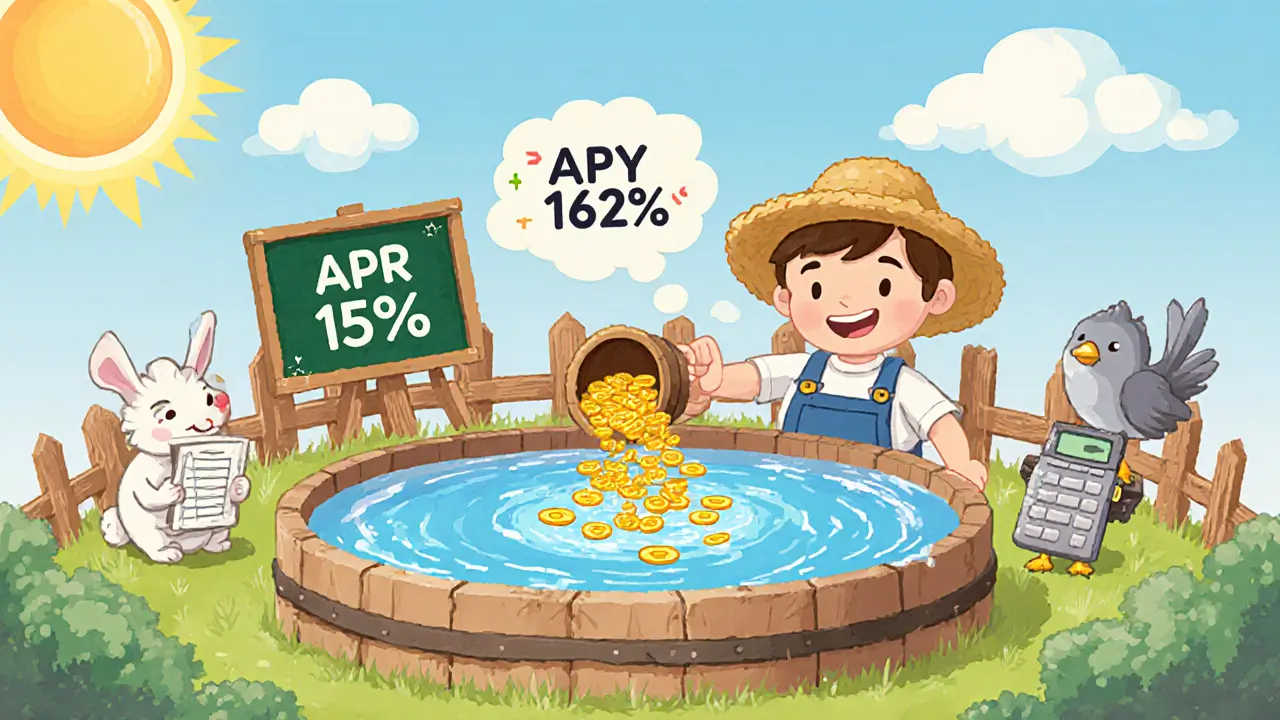
DeFi Yield Farming Return Calculator
Results Summary
Formula Used: Net Return = [(Fee Share + Token Rewards) × (1 - Platform Fee)] - Impermanent Loss - Risk Buffer
Trying to figure out if a DeFi farm will actually boost your portfolio? Most growers get stuck on the headline numbers-15% APR, 30% APY-without digging into what those figures really mean or how fees, token rewards, and risk factors change the picture. This guide walks you through every step of the calculation, from simple interest to leveraged strategies, so you can see the true net return before you lock any capital.
Key Takeaways
- APR shows simple interest; APY adds compounding and gives a more realistic view.
- Trading fees, governance token rewards, and platform fees can swing net returns by several percentage points.
- Impermanent loss and smart‑contract risk can erase gains, especially in volatile pairs.
- Leveraged farms multiply both profit and loss; include borrowing costs in your model.
- Use a layered calculator: start with APR/APY, then add fees, rewards, and risk adjustments.
1. Core Concepts You Need to Know
Yield Farming is a DeFi practice where investors lock tokens into a Liquidity Pool to earn interest, fees, or extra token rewards. The goal is to turn idle assets into a revenue stream, but the math behind the promised returns can be tricky.
Annual Percentage Rate (APR) measures simple interest over a year. It ignores any compounding that may happen when rewards are automatically reinvested. For a $1,500 investment at 15% APR, the calculation is straightforward: $1,500×0.15=$225, yielding $1,725 after one year.
Annual Percentage Yield (APY) captures the effect of compounding. If the same 15% rate compounds daily, the APY rises to about 16.18% because each day’s earnings are added to the principal for the next day’s calculation.
Beyond APR and APY, two more elements shape real returns:
- Governance Token incentives-extra tokens like CRV or COMP distributed to liquidity providers.
- Impermanent Loss, the value erosion that occurs when the relative price of the pool’s assets shifts.
Every calculation must also consider Smart Contract risk. A bug or hack can wipe out your entire position, turning a high‑APY lure into a total loss.
2. APR vs. APY: Simple vs. Compounded Returns
Start with the base rate the protocol advertises. Many platforms list APR, but investors often treat it as APY, leading to over‑optimistic expectations.
| Metric | Formula | Example (15% rate, $1,000) |
|---|---|---|
| APR (simple) | Principal×Rate | $1,000×0.15=$150 → $1,150 total |
| APY (daily compounding) | Principal×(1+Rate/365)^{365} | $1,000×(1+0.15/365)^{365}≈$1,161 → $161 profit |
| APY (weekly compounding) | Principal×(1+Rate/52)^{52} | $1,000×(1+0.15/52)^{52}≈$1,158 |
Notice how even a modest increase in compounding frequency adds a few extra percentage points. When platforms automatically reinvest rewards, APY is the metric you should trust.
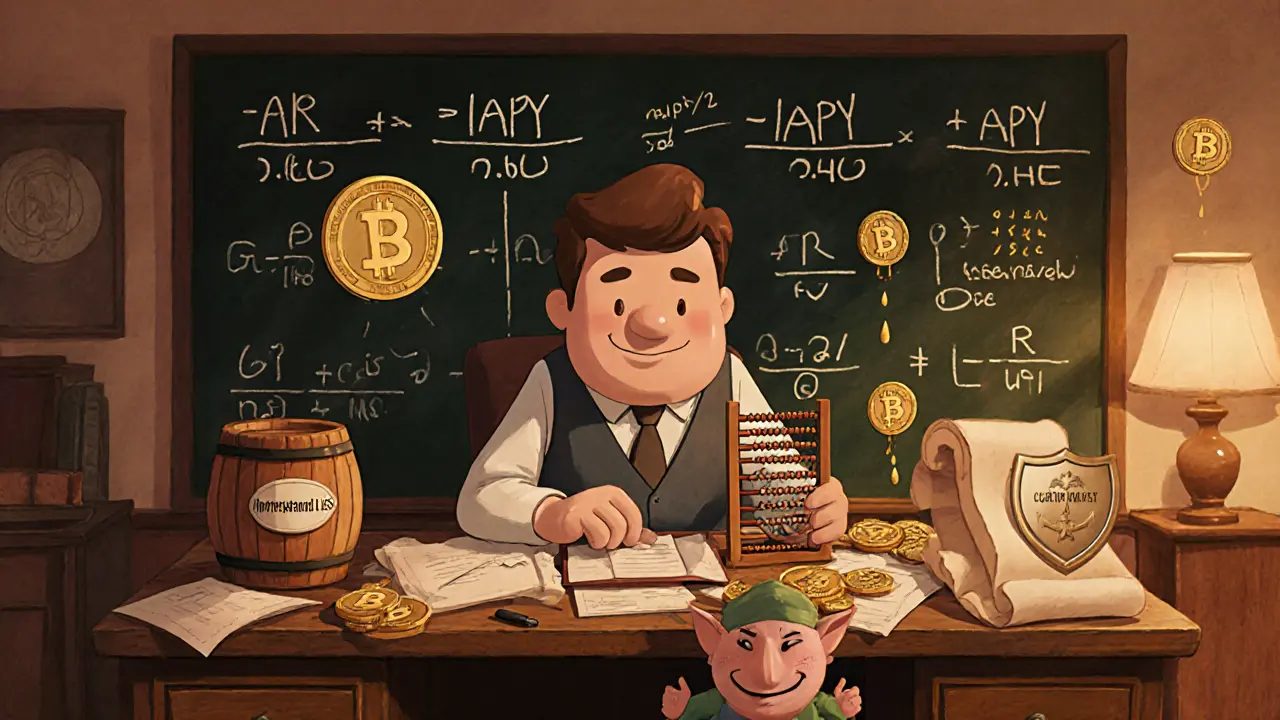
3. Adding Platform Fees and Trading Volume Rewards
Liquidity providers earn a slice of the trading fees generated by the pool. The fee share is usually a proportion (e.g., 0.3% per swap) divided among all LPs based on their stake.
- Calculate daily trading volume for the pool (e.g., $10M).
- Apply the fee rate (0.3%→$30,000 daily fees).
- Determine your share: (Your LP amount ÷ Total pool liquidity) × $30,000.
If you contributed 5% of the pool, you’d earn $1,500 in fees per day before any token rewards.
Next, layer in Governance Token rewards. Most farms distribute a fixed amount of token per block or per day. Convert that token amount into USD using the current market price, then add it to the fee earnings.
Finally, subtract platform fees (often 5‑10% of earned rewards). The net formula becomes:
Net Return = (Fee Share + Token Rewards) × (1-Platform Fee %)
Plugging realistic numbers can shift the effective APY from the advertised 30% down to 22% or up to 35% if the token price spikes.
4. Accounting for Impermanent Loss and Smart‑Contract Risk
Impermanent Loss (IL) occurs when the price ratio of the two assets in a pool drifts apart. The loss is “impermanent” because it only materializes when you withdraw. The classic formula for a two‑asset pool is:
IL = 2 × √(price_ratio) ÷ (1 + price_ratio) - 1
For example, if the price of token A doubles relative to token B (price_ratio = 2), IL ≈8.5%. If your pool’s earned fees are only 5% annually, the net return becomes negative.
Smart‑contract bugs add a binary risk-either the contract works or it doesn’t. While you can’t quantify a specific percentage, seasoned farmers allocate a risk buffer (often 2‑5% of capital) and treat any potential loss as fully absorbing that buffer.
5. Leveraged Yield Farming: Multiplying Gains-and Losses
Leveraged Yield Farming lets you borrow extra capital against your deposited collateral to increase farm size. The math expands the basic return model:
Total Return = (Base Return×Leverage) - Borrowing Cost - Liquidation Risk
Assume you stake $1,000 at an APY of 20% and borrow $9,000 at 5% annual interest (10× leverage). Your gross profit is ($10,000×0.20)=$2,000. Borrowing cost is ($9,000×0.05)=$450. Net profit = $2,000-$450=$1,550, which is a 155% return on your original $1,000-if the market stays stable.
However, if the pool’s assets lose 10% in value, your leveraged position loses $1,000 (10×$100) plus the borrowed amount may be liquidated, wiping out the equity. Hence, always model both upside and downside, and keep a safety margin above the liquidation threshold (commonly 150% collateralization).
6. Using Yield Farming Calculators Effectively
Most DeFi dashboards embed calculators that ask for:
- Principal amount
- APR or APY
- Compounding frequency (daily, weekly)
- Estimated daily trading volume
- Governance token reward rate
- Platform fee percentage
- Projected impermanent loss (often based on historical volatility)
Enter realistic values-don’t just copy the headline APY. Cross‑check with a second calculator to catch bugs. When you see a big gap between the two, dig into which assumptions differ (e.g., one includes token price appreciation, the other doesn’t).
For leveraged farms, add a separate row for borrowing cost and set a liquidation trigger price. Some advanced tools even let you model price paths with Monte Carlo simulations, but a simple “worst‑case 20% price swing” scenario is enough for most retail investors.
7. Practical Checklist Before You Farm
- Verify the protocol’s audit reports and community reputation.
- Record the advertised APR, convert to APY using the actual compounding schedule.
- Calculate fee share based on current pool volume.
- Convert governance token rewards to USD and add them to fees.
- Estimate impermanent loss using recent price volatility of the pair.
- Subtract platform fees and add a 2‑5% risk buffer for smart‑contract exposure.
- If leveraging, include borrowing rates and keep collateral >150% of borrowed value.
- Run the numbers in at least two independent calculators; reconcile any differences.
If the final net APY still looks attractive compared to a low‑risk benchmark (e.g., a stablecoin savings rate), you’ve got a solid candidate. If the net number drops below your risk tolerance, look for a different pool or wait for fees to rise.
Frequently Asked Questions
What’s the difference between APR and APY in DeFi?
APR calculates simple interest on the principal, ignoring any reinvestment of rewards. APY incorporates compounding-if the protocol automatically stakes earned tokens, APY reflects the higher effective return.
How do trading fees affect my yield?
Fees generated by swaps in the liquidity pool are split among all LPs proportional to their share. Calculate daily pool volume, apply the fee rate (often 0.3%), then multiply by your ownership percentage. This fee income is added to any token rewards before deducting platform fees.
What is impermanent loss and how can I estimate it?
Impermanent loss happens when the price ratio of the two assets in a pool changes. Use the formulaIL=2×√(ratio)÷(1+ratio)-1. Plug the expected price change (e.g., a 2× rise) to get a percentage loss, then subtract it from your fee+reward earnings.
Is leveraged yield farming worth the risk?
Leverage can boost returns dramatically, but it also amplifies losses and adds borrowing costs. You should only use leverage if you have a clear exit plan, can tolerate liquidation, and have modeled both upside and downside scenarios.
Which calculators give the most reliable results?
Pick tools that let you input APR/APY, compounding frequency, fee share, token reward rate, and a risk buffer. Popular choices include DeFi Pulse’s farm calculator, Yieldwatch, and Dune Analytics dashboards. Always cross‑check two calculators to catch mismatched assumptions.

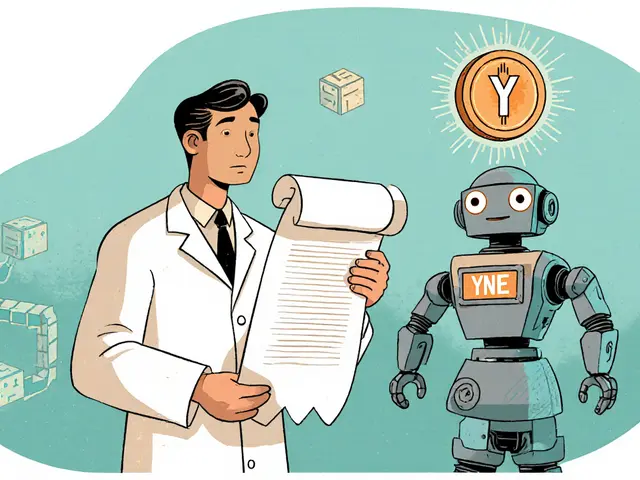
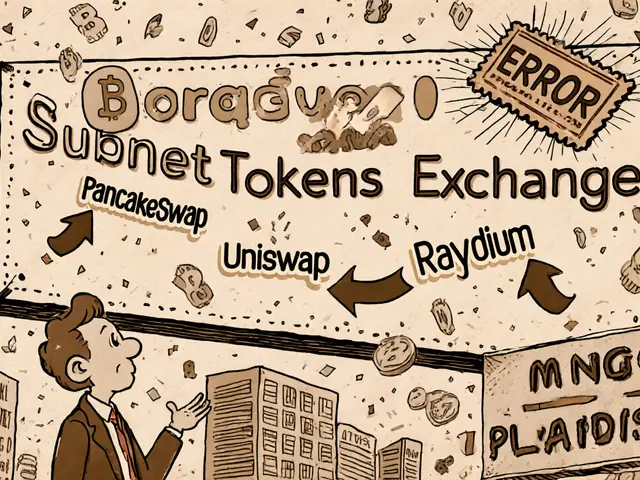
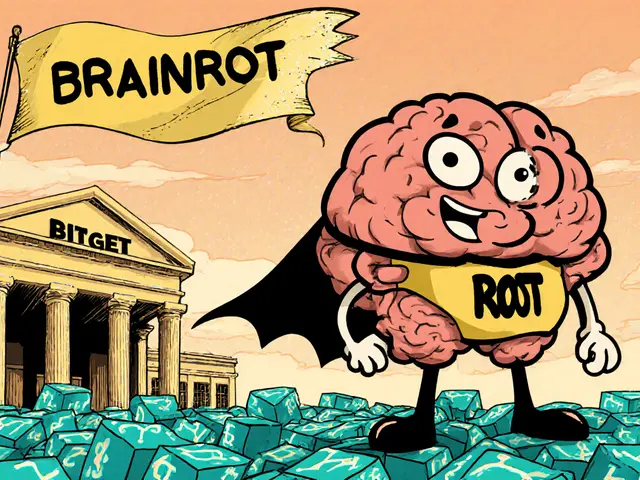

Comments (19)
James Young
APR vs APY is basic finance 101 but everyone still gets fooled by 30% APY banners. You think you're making bank until you realize the platform takes 8% in fees, your token reward crashed 60%, and you got rekt by impermanent loss on a 50/50 ETH/USDC pool. Stop chasing hype. Do the math or get owned.
And don't even get me started on leveraged farms. That's not investing, that's gambling with borrowed money and a prayer.
I've lost more capital to 'high-yield' farms than I've made. The only ones winning are the devs selling their tokens at the top.
Use the calculator in the post. Not some shady DeFi dashboard that auto-fills optimistic numbers. Real numbers, real risks, real outcomes.
Also, if you're using a protocol without a full audit from CertiK or PeckShield, you're already 90% dead. Don't act surprised when your funds vanish.
Stop being a yield farmer. Start being a risk analyst.
Chloe Jobson
Just wanted to say thank you for breaking this down so clearly. I was drowning in APY charts and felt totally lost.
Now I get why my last farm lost money even though it showed 45% APY. The token rewards were worthless and the fees ate everything.
Also, impermanent loss hit harder than I thought. My ETH/DAI pool dropped 12% even though ETH went up. Mind blown.
Will use your checklist next time. Seriously helpful.
Andrew Morgan
Bro I just got back from a 3-day DeFi retreat in Bali and let me tell you the vibes are different now
Everyone's talking about APY like it's a religion but nobody's talking about the soul of the protocol
I mean what are we even doing here? Are we building wealth or just chasing digital ghosts with a calculator
I used to farm like a maniac now I just hold BTC and meditate
But if you must farm at least use Dune Analytics and pray to the blockchain gods
Also I saw a guy lose 12k last week because he didn't check the liquidation threshold
Life is short man
Don't be that guy
Michael Folorunsho
Typical American retail investor mentality. You think you can outsmart smart contracts built by engineers with PhDs in cryptography? You don't even understand basic compound interest yet you're leveraged 10x on a farm with no audit.
APY is meaningless if the underlying token has no utility. Most of these governance tokens are pump-and-dump schemes dressed up as DeFi.
And you call this innovation? This is financial theater. A casino with a blockchain logo.
Real investors don't farm. They buy blue-chip assets and hold. The rest are just noise.
Also, if you're from the US you're already at a disadvantage. SEC is coming. Your assets will be frozen. You're playing with fire.
Stop pretending this is finance. It's a Ponzi with better graphics.
Roxanne Maxwell
Thank you for writing this. I was so overwhelmed trying to figure out my first farm and felt stupid asking questions.
This made it feel doable. I printed the checklist and put it on my fridge.
Also the part about impermanent loss? That was a lightbulb moment. I thought I was losing money because I was bad at investing. Turns out it's just how pools work.
You're helping people. Seriously.
Jonathan Tanguay
Okay so I just did the math on this and I think you're all wrong because you're not accounting for the hidden tax implications and the fact that the IRS treats every token reward as taxable income at the time of receipt not when you sell so your net return is actually lower than you think and also most people forget that gas fees on Ethereum are like 20-50 bucks per transaction and if you're compounding daily that's like 6000 a year in gas alone so your 30 percent APY is really like 12 percent after fees and taxes and gas and then you add impermanent loss and the fact that 90 percent of these protocols are rug pulls so you're basically just giving your money to a guy in a Discord server who says he's from the UK but his IP is in Nigeria and then you get liquidated because you didn't use a 150 percent collateral ratio which 99 percent of newbies don't know about because they just click stake and hope for the best and then they cry on Reddit and that's why I stopped farming and now I just buy gold and bury it in my backyard because at least then you can't hack dirt and also the government can't seize dirt unless they dig it up which they won't because it's too much work and also I'm not even sure if the IRS can tax dirt so yeah that's my strategy and I'm not even joking
Ayanda Ndoni
Man I just read this and I'm like why even bother
I got 2000 bucks in a farm and it went to zero last month
Now I just chill
Watch Netflix
Drink cold beer
Forget about APY
Life too short for this stress
Why you all so serious
It's just crypto man
It's not real money
It's digital play money
Why you all acting like you lost your house
It's just tokens
Relax
Go outside
Touch grass
And stop trying to be a finance bro
Elliott Algarin
There's something poetic about trying to quantify the unquantifiable.
We build models to predict outcomes in a space built on trustless code, anonymous devs, and volatile sentiment.
The calculator gives us comfort.
But the truth? We're all just guessing with spreadsheets.
Maybe the real yield isn't in the numbers.
Maybe it's in the quiet moment when you decide not to click 'stake' at all.
That's the return no formula can capture.
John Murphy
Good breakdown
Just one thing I'd add
Don't forget to check the token's circulating supply
Some farms give you 1000 tokens a day but the total supply is 10 billion
So your reward is worth 0.02 cents
And the dev team holds 40 percent
And they're dumping it on uniswap every week
So your 'reward' is just a price sink
Always check tokenomics before you farm
APY is a lie if the token is garbage
Zach Crandall
While I appreciate the technical exposition presented herein, one must acknowledge the epistemological limitations inherent in predictive financial modeling within decentralized ecosystems.
Yield is not merely a function of compounding frequencies or fee structures-it is a manifestation of emergent socio-economic behavior under conditions of asymmetric information.
Furthermore, the reliance on historical volatility as a proxy for impermanent loss is a classical fallacy, as market dynamics are increasingly influenced by algorithmic trading bots and MEV extraction mechanisms beyond retail comprehension.
One must therefore approach yield farming not as an investment strategy, but as a probabilistic experiment in digital governance-a noble but perilous endeavor.
With due respect to the author, the checklist is commendable, yet insufficient without a deeper ontological inquiry into the nature of value in a post-trust financial paradigm.
Akinyemi Akindele Winner
Y’all be out here calculating APY like it’s a math test while the whole system is a rigged carnival ride
These farms? They ain’t no different from a Nigerian prince texting you ‘I need 5000 to release my inheritance’
Only difference? You got a fancy dashboard and a whitepaper that says ‘decentralized’
And you still send your cash
Bro the only thing compounding here is your stupidity
And the devs? They already cashed out and bought villas in Dubai
While you’re stuck wondering why your 40% APY turned into a 100% loss
Wake up
This ain’t finance
This is digital voodoo
And you’re the sacrifice
Patrick De Leon
APR and APY are irrelevant when the entire system is a regulatory time bomb
US citizens are being targeted by the SEC for DeFi participation
Every farm you join today could be labeled a security tomorrow
And your assets frozen
And your identity exposed
Don’t be fooled by the numbers
This isn’t innovation
This is financial suicide with a blockchain logo
And you think you’re smart because you did the math
You’re not smart
You’re just late
MANGESH NEEL
How can you people be so naive
Do you even know how many of these farms are run by Chinese bots with 100 wallets
They pump the token
Then they drain the liquidity
Then they leave
And you cry on Reddit about your 15% APY
Bro I lost 20k last year
Because I trusted a farm with a cute logo and a Telegram group with 50k members
They had a whitepaper
They had a team
They had a roadmap
And then poof
They vanished
APY doesn’t mean anything
Trust is dead
And you’re still calculating
Sean Huang
Have you ever considered that the entire DeFi system is a quantum entanglement experiment orchestrated by the Illuminati to transfer global wealth into a single blockchain-controlled wallet?
They use APY as a lure because they know humans are hardwired to chase exponential growth
But the real goal? To create a global financial monoculture where your wallet is your ID
And your crypto is your soul
And when the Fed finally shuts it down
They’ll say it was a hack
But it was never a hack
It was the plan
And you
Are the final node
Staking your life
For a 25% APY
That doesn’t exist
It’s all a simulation
And you’re the test subject
And your calculator
Is the trigger
:)
Ali Korkor
Man this post saved me. I was about to throw 5k into a farm with 50% APY.
Now I’m just holding stablecoins and chilling.
You’re a legend.
Thanks for not making it sound like a textbook.
Real talk. Real numbers.
Keep doing this.
madhu belavadi
I just lost everything.
Wish I read this before.
Now I’m broke.
And sad.
But at least I know why.
Dick Lane
Good stuff
Just one thing
Don't forget to check the contract owner's wallet
Some devs have a 20% ownership
And they can mint more tokens
Then dump them
And you're left with nothing
And the APY looks great until the token crashes
Always check the tokenomics
Not just the numbers
Norman Woo
Wait so if the price of the token goes down 20% and I'm leveraged 5x
Then I lose 100% of my money
But the farm still says 30% APY
So I'm just supposed to ignore that?
And what if the gas fees are higher than my reward?
And what if the whole thing gets hacked?
And what if the dev is a scammer?
And what if the blockchain gets forked?
And what if the IRS comes after me?
So why am I even doing this?
Why do I keep clicking stake?
Why do I keep believing?
Why do I still think this is a good idea?
Help
James Young
Now I see why you’re still here. You didn’t learn. You just got scared.
That’s the cycle. Lose money. Cry. Read a post. Promise to change.
Then next week you see 80% APY on a new farm with a dog logo.
And you’re back.
It’s not the math you don’t get.
It’s the hope.
And that’s the real risk.